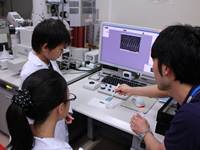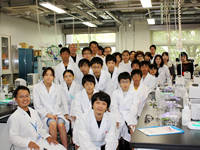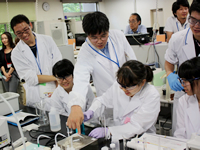Last August at Tokyo Institute of Technology, a science seminar was held by ERATO IYODA Supra-integrated Material Project group, and 24 elementary, 15 junior high school and 14 high school students themselves challenged scientific experiments in state-of-the-art laboratories. The topic of this seminar was "bio template", which is the technique for molding living things into new materials. Prof. IYODA Tomokazu's group is devoted to fabricating microscopic coils of metal-plated algae having a helical structure and researching the application of these coils to electronic materials including antennas.
The participating elementary school students observed living things through an electronic microscope. The junior high school students performed three types of experiments on the precipitation of metals by use of a redox reaction. The high school students attended lectures and experiments directly linked with research in the IYODA project. Although some of those contents were difficult to follow, each student seemed to enjoy all of the experiments and lectures with wide-open eyes. As regards the class for high school students, it lasted over three hours, yet some students indicated that they wanted to continue their experiments.
Having been exposed to the passion of the participants was a great opportunity for researchers to realize just how important the outreach activities are as well as to get inspiration for their research.

The elementary school students were wrapped up in the microscopic world by sketching neighboring leaves and flowers through the optimal microscope and observing butterfly wings through the electronic microscope.

The junior high school students attempted to fabricate hand mirrors utilizing a "silver mirror reaction" and performed an experiment titled "ginju" that demonstrates the difference in the ionization tendency of metals. They also conducted "metal-processing" of leaves, pastas and other personal effects.

The high school students fabricated microscopic coils of plated algae and observed these coils through the electronic microscope. They also experienced the principle of receiving antennas through an experiment with the "Coherer" applying the property of allowing an electric current to flow between metal pieces upon receiving radio waves.
JST, an integrated organization of science and technology in Japan, establishes an infrastructure for the entire process from the creation of knowledge to the return to the society. For more information, visit http://www.jst.go.jp/EN/